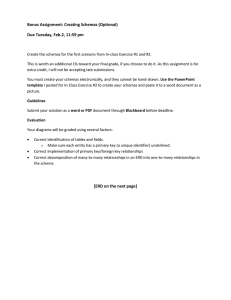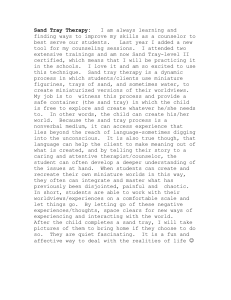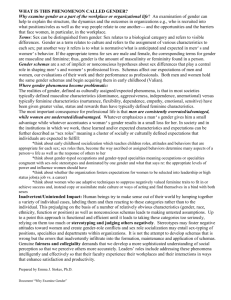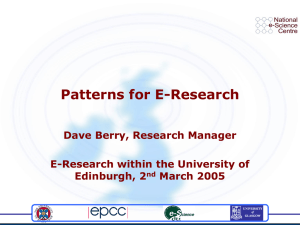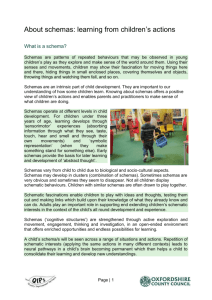Characteristics of Effective Learning
advertisement
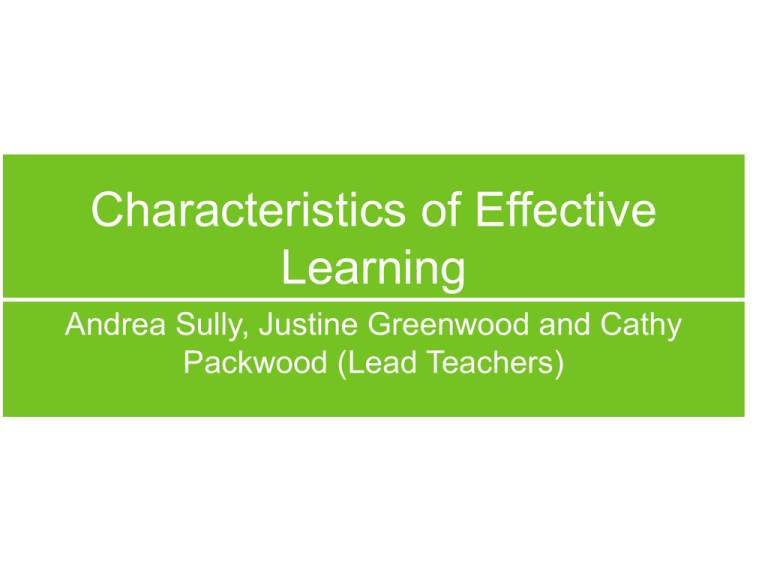
Characteristics of Effective Learning Andrea Sully, Justine Greenwood and Cathy Packwood (Lead Teachers) aims for the day • To familiarise ourselves with the Characteristics of Effective Learning • To have more confidence in understanding how to develop the CofEL in our own settings, than when we arrived • To plan how to share our learning today with others How do children learn? How do you think we learn? Group Activity Six human needs in order to be able to learn Certainty We must grow Variety Significance Connection and love Needs of the personality Contribute beyond ourselves Needs of the spirit What do children need beyond having their physical needs satisfied? Agency: influence over what they do and some choices Belonging: being cared for, part of a community Competence: the feeling of being successful Motivation and the brain Even if a learner is personally motivated to learn a topic, if the learning content itself isn't motivating, the learner's brain will do everything possible to look for something more interesting. This applies to both getting and keeping attention, as well as memory. Remember, you can't do anything until you get past the brain's ‘is this worthwhile’ filter! And to the brain, a dry, dull explanation is definitely not very worthy of attention (regardless of how much your mind cares about the topic or content). Children are sophisticated thinkers... Privileged Domains • Physical concepts • Biological causality • Early number concepts • Early attention to Language They show us their thinking.... • through their pre-occupation or schemes of thought which are seen most often in their self-chosen play • in their questions (both verbal and nonverbal) which are based on their search for explanations • in their talk while they are ‘doing’ - pole bridging The Children we Teach - Susan Isaacs 1932 the love of bodily movement and perfecting bodily skills the interest in actual things and events, the discovery of the world without the delight in make believe and the expression of the world within Playing and Exploring Engagement • Finding out and exploring • Playing with what they know • Being willing to ‘have a go’ What might it look like? • experience • imagination • stories • ‘Can do’ attitude Active Learning - Motivation • Being involved and concentrating • Keeping on trying • Enjoying achieving what they set out to do What might it look like? You’re very clever... You’ve worked very hard on that... Dweck’s theory of growth and fixed mindset What can you say about my picture? Creating and Thinking Critically thinking • Having their own ideas • Making links • Choosing ways to do things What might it look like? Young children are highly complex thinkers, and they need to be equipped, and challenged, to play and to think as well as to know. No-one can teach effectively without professional knowledge about how children’s thinking and knowing develops...Knowing about schemas enables professional educators to extend their own thinking and further refine and develop their practice.’ Cathy Nutbrown, 1994 Named schemas • dynamic vertical • dynamic back and forth / side to side • dynamic circular • going over and under • enveloping and containing space • transporting • going through a boundary • going round a boundary What are schemas? • Patterns pervade children’s play, their thinking and their language • These patterns are described as ‘forms of thought’ (schemas) • These ‘forms of thought’ can be nourished with worthwhile ‘content’ • The ‘content’ of a schema relates to the resources and experiences we offer Trajectory; vertical / horizontal / diagonal a child may drop things from their cot, make arcs in their food, play with running water, climb up and down and jump off furniture, line up toys, build tall structures and knock them down, throw Transporting a child may carry all the bricks from one place to another in a bag, the sand from the tray to the home corner in a bucket, push a friend around in a pram Containing / enclosure - a child may put their thumb in and out their mouth, fill up and empty containers of all kinds, climb into large boxes, sit inside tunnels, build enclosures with bricks, make dens Positioning a child may put things on their head, place things side by side, prefer their custard next to their pudding not over it, lie on the floor or under the table, walk around the edge of the sandpit. And some more examples of schematic play... • Enveloping - a child may cover themselves with their flannel when washing, wrap dolls up in blankets, sit in the same tray and cover their legs with sand, cover their whole painting with one colour, wrap toys up in sticky tape • Rotation - a child may be fascinated by the spinning washing machine, love anything with wheels, roll down a hill, enjoy spinning around • Connection - a child may distribute and collect objects to and from a practitioner, spend time joining the train trucks together, stick the masking tape from the table to the chair, like puzzles • Transforming - a child may add juice to their mashed potato, or sand to the water tray, enjoy adding colour to cornflour or dough, enjoy toys that change shape Tool Words Concepts similiar identical different Verbs remember comment question Nouns team imagination mystery create Drawing my thinking Rich Tasks • Is the task worth doing? • Is it interesting enough to talk about? • Will it develop and draw out the Characteristics of Effective Learning? • Will it provoke questions (verbal or nonverbal) from the children? And at the end of the day... The practitioner is smiling... ...and the children are, quite rightly, more tired because they have worked harder. Reflect and plan • what could be developed further in our practice? • who needs to know and help you in your setting? • how can it be achieved? • when? • how can we help you further?

